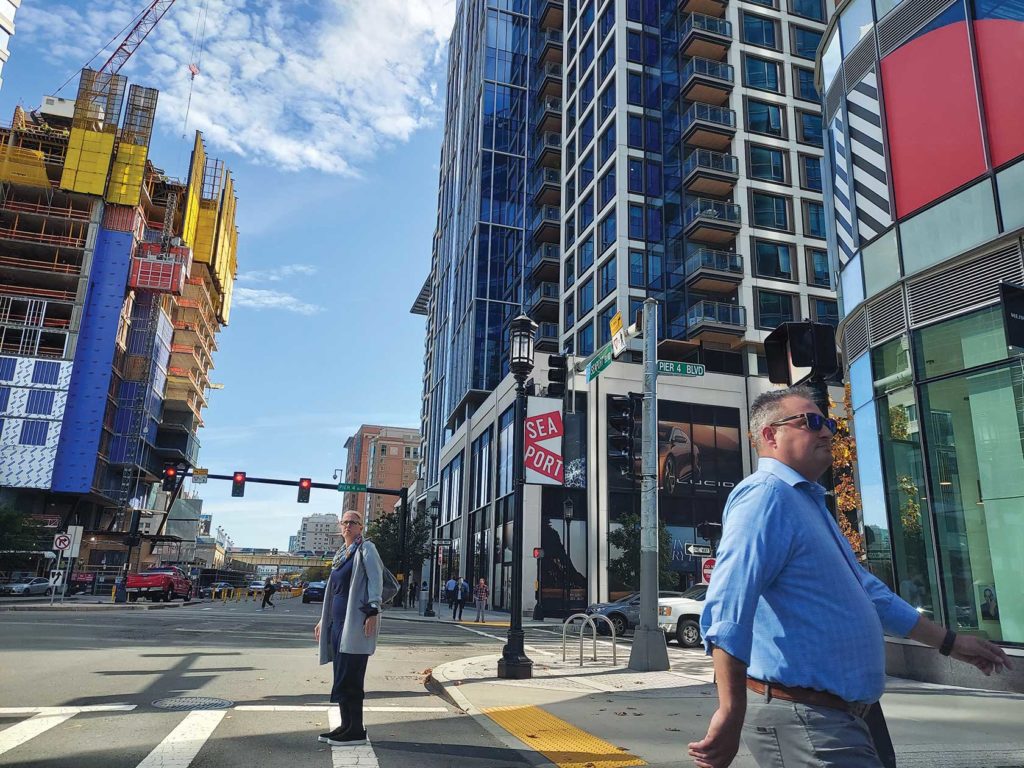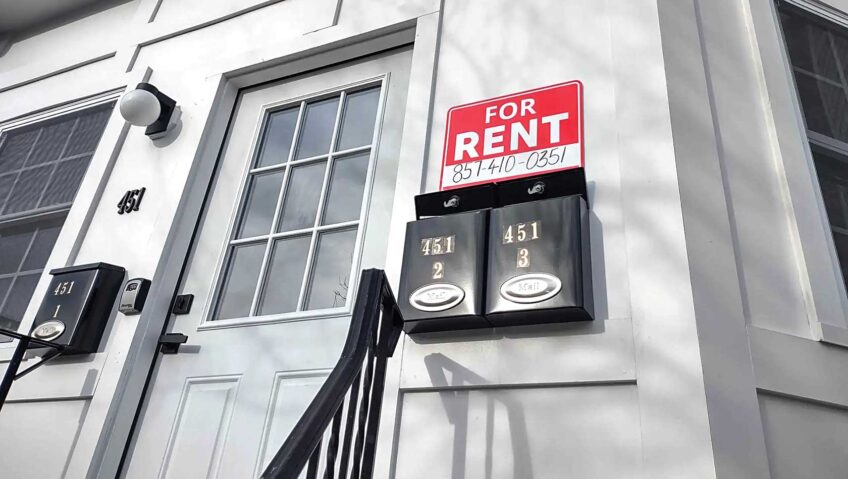Does the BPDA have a vision for Boston’s future?
Housing advocates see a role for independent planning

As commuters made their way through Fields Corner last week, a group of activists with the group Dorchester Not for Sale handed passersby flyers bearing the message, “Not another Seaport!” urging neighborhood residents to join their call for a six-month moratorium on the city’s approval process for a planned 36-acre apartment and lab space project.
Activists fear the Dorchester Bay City project, which calls for 1,970 rental units and 4 million square feet of lab, office and retail space, will sail through the Boston Planning and Development Agency’s (BPDA) approval process without developers addressing their calls for greater affordability and concrete steps to mitigate the effects of sea level rise in the neighborhood.
“We’re feeling quite frustrated that it’s ‘business as usual’ at the BPDA,” said Dorchester Not for Sale organizer Carolyn Chou. “We feel with a project of this size and scale, the process needs to be slowed down for the mayor’s team to get a handle on it.”
The project is one of several major, multi-acre developments currently making their way through the BPDA approval process. These projects are moving forward before Mayor Michelle Wu has made good on her campaign promise to break apart the Boston Planning and Development agency, separating the city’s planning function from the agency, which manages the approval process for large real estate projects.
Wu has said she will make no changes to the BPDA until her administration hires a new planner, a position she’s currently seeking to fill. In the meantime, the BPDA’s ongoing approval processes are moving ahead full steam, with developments set to bring thousands of housing units and millions of square feet of commercial space heading toward BPDA board votes.
The projects in the BPDA pipeline will almost certainly change the character of the city, and some say the change may be for the worse. The city is already bursting with new condo developments and apartment complexes where the majority of new units are one-bedrooms and studios — housing types not suited for families — with rents far beyond the reach of what most current Boston residents can afford.
Luxury condo buildings such as Millennium Tower in Downtown Crossing boast $30 million units that sit empty as foreign investors park their money in Boston real estate, and underscore the difficulty of meeting Boston’s affordable housing crisis through production alone. While Boston saw more than 30,000 new units permitted or constructed during the eight years of the administration of former Mayor Martin Walsh, the new units seemed to do nothing to bring prices down.
“My fear is Boston turning into Seattle, where you have outpriced all the low-income and middle-class people, but also a lot of the upper middle class,” said former City Councilor Tito Jackson. “Boston has to get to the point where we plan before we develop.”

Winthrop LLC’s 115 Winthrop Square 1.4 million square foot mixed-use project rises above Devonshire Street. BANNER PHOTO
Avoiding another Seaport
Jackson and others point to the Seaport District, a neighborhood of towering steel and glass condominium and office buildings with little public space and virtually no economic or racial diversity — a neighborhood in which 81% of residents are white and have a per-capita income nearly thrice that of the city as a whole.
The Seaport stands in stark contrast to most other Boston neighborhoods, where streets are walkable, parks plentiful and the local businesses cater to clientele with a range of incomes. Where other Boston neighborhoods have community centers, theaters and public infrastructure such as libraries and schools, the Seaport District is almost entirely occupied by profit-generating land uses.
BPDA officials interviewed by the Banner acknowledged that development in the Seaport District, which began under the administration of the late Mayor Thomas Menino, is not ideal.
“Districts like the Seaport present an important teaching moment for the agency,” said BPDA Deputy Chief of Staff Dana Whiteside. “It presents an opportunity to think about and discern what are the things that have gone very well and what are the things that may be considered challenges.”
Whiteside said the BPDA is taking a different, more inclusive approach to planning in other neighborhoods.
“The hope and the goal for us as an agency is to take a lot of the input and data that we have and to make sure that both the developers and stakeholders come together to create a project that is going to be of mutual benefit to a vast number of constituents,” he said, “whether it’s downtown or Mattapan or Hyde Park or East Boston.”
But Fort Point resident Steve Hollinger, who advocates for responsible neighborhood development in the waterfront area, says developers are now applying the same formula of maximized housing and office space and minimal civic space to projects in South Boston and Dorchester, including Dorchester Bay City.
“I think Boston is being hollowed out by the BPDA because it’s being driven by market forces almost exclusively,” he said.
Hollinger isn’t alone in seeing Boston’s current development regime as driven by developers’ desire for profit.
“The history of development in Boston has been about profit over people and pushing Black people out in pursuit of profit,” says Armani White, an organizer with the group Reclaim Roxbury. “The city has subscribed to the line of thinking that more housing, no matter what it costs, will make the city more affordable for renters. That’s been shown not to be true in Boston. It’s just not the case.”
City officials have taken steps in recent years aimed at preserving some affordability in Boston. Of all the units developed during the Walsh administration years, 20% were designated affordable to income levels ranging from 30% of the region’s federally designated area median income (AMI) to 120%. That latter figure means an individual earning $101,500 can qualify for affordable housing in Boston.
Six-figure earners in Boston may need the help. In January, the housing rental website Zumper said Boston is poised to surpass the San Francisco Bay area as the most expensive rental market in the country.
“More than half the people in the city qualify for affordable units,” noted James Jennings, professor emeritus of urban and environmental policy and planning at Tufts University.
BPDA Director of Real Estate Devin Quirk said Boston leads the nation in affordable housing development, noting that no other major city has a percentage of affordable housing higher than the 20% currently in Boston.
“We are doing something right to protect housing choice and provide and protect income diversity in our on our city,” he said. “But that is not to say that it is enough.”
Private developers building 10 or more units of housing are required to set aside 13% as affordable. On city-owned land, Quirk noted, developers are held to a standard of one-third deeply affordable, one-third moderately affordable and one-third market rate — a requirement that was developed with Roxbury community members and now applies to BPDA-owned land across the city.
“I think that’s a very clear example of a process where the community was in the driver’s seat,” he said.
Whiteside said that on projects being constructed on privately-owned land — the majority of projects under the BPDA’s purview — the city regulates development through the Article 80 process, through which developers are required to have their plans vetted by neighborhood residents.
On those projects, however, the city acts as mainly a convener and exercises limited say in shaping a project. That puts developers in the driver’s seat for the city’s future, housing activists say
Private vs. public benefit
Jennings believes it’s critically important that Boston pivot away from the market-driven real estate planning model under which it’s currently operating.
“The city has to look at how development is related to everything else,” he said. “It’s not just about lab space. Development can’t be done in a silo. If we make a development decision, it has to be consistent with a citywide vision that includes socioeconomic planning.”
It’s not that the BPDA doesn’t do planning. Under the Walsh administration, the agency undertook neighborhood planning processes such as PLAN JP/Rox, which focused on the areas around Jackson Square, Egleston Square and Forest Hills. The most common way the city has approached planning is through its zoning code, which dictates factors such as residential or industrial use and building height and density in neighborhoods. But in recent years, critics say, the city’s Zoning Board of Appeal has sided with developers seeking to override zoning codes more than it has with abutters seeking to uphold them.
But the overwhelming majority of acreage under development in Boston is in private hands, whether it’s HYM Investment Group’s planned 10,000-unit development at the former Suffolk Downs racetrack on the East Boston border with Revere or Harvard University’s planned redevelopment of 140 acres in Allston.
The city often overrides the very zoning plans created for neighborhoods by designating them as Planned Development Areas, allowing developers to bypass restrictions on building height and land use.
Hollinger argues there’s a strong public interest in what is built on private parcels, noting public investments in transportation and other critical infrastructure. In the case of Dorchester Bay City, Hollinger cites government investments in Moakley Park improvements, the Boston Harbor cleanup, renovations to the JFK/UMass Red Line stop, and improvements in highway and road infrastructure.
“The owners of the land did nothing,” he said. “They left it as parking lots and allowed the government to improve the surrounding area. When the BPDA comes in and allows them to build, there’s hundreds of millions of dollars of value they’re handing over to the developer. They’re being handed a big windfall.”
Yet, Hollinger says, the BPDA almost never uses its authority to push for the public interest on projects. Instead, developers are replicating the Seaport District’s monotonous rhythm of office and lab space, steel-and-glass luxury condo towers, and little to no civic space.
Jackson says the need for planning that is responsive to the needs of Bostonians is urgent. The city has been losing Black residents to lower-cost housing markets such as Brockton, a city that boasts the highest number of homes being purchased by Blacks in the state. Working-class and middle-class white and Latino families have also left the city, leading to declining enrollment in the city’s public and parochial schools, Jackson notes.
“We’re displacing children,” he said. “We’re displacing the future of the city of Boston. If we continue this way, we’re going to wake up one day to a city that doesn’t look like and feel like and have the soul of the city of Boston.”







